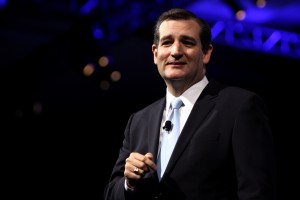
CNN, Larry Summers, and Paul Krugman. Right on schedule, the elites are piling on Sen. Ted Cruz for his support of the gold standard. Their commentary ranges from subtly wrong, as in the case of CNN, to badly misguided (but predictable) ridicule from Dr. Summers and Prof. Krugman.
On December 28, CNN’s Heather Long wrote “Why Ted Cruz’s gold standard push is a bad idea.” Ms. Long can’t really be faulted for relaying the conventional wisdom.
Yet one wishes CNN would expand its sources on this subject — a topic likely to recur in the presidential contest — to include expert gold standard proponents such as Reagan Gold Commissioner Lewis E. Lehrman, publisher Steve Forbes, financier Sean Fieler (chairman of The Pulse’s parent organization), George Mason University economics professor Lawrence White, or even myself, probably the most prolific writer in the contemporary mainstream financial and policy media on the gold standard.
Jack Kemp, prime sponsor when in the House of The Gold Standard Act of 1984 (co-sponsored by then Reps. Newt Gingrich, Vin Weber, and Connie Mack), later vice presidential candidate and cabinet secretary, is no longer with us. Yet his prestige only continues to grow. He was awarded by President Obama the Presidential Medal of Freedom, one of the nation’s two highest civilian honors.
This matters. The question of the gold standard in fact is far more respectable, and more nuanced, than Ms. Long’s column suggests.
Ms. Long’s opening is astute: “It’s a plan that is getting the ‘you’ve got to be kidding me’ reaction from the business community. … But economists … see it as a relic that should stay in the past.” That said, this observation is sadly incomplete. And it is too thinly sourced.
Truly the elites have a propensity to ridicule gold. Dr. Summers, for example, in the Washington Post Wonkblog recently referred to “stone-age monetary ideas like a return to the gold standard.”
Prof. Krugman, in his New York Times column, “Doubling Down on W,” with classic Krugman perversity, slams the G.O.P. for “doubling down” on President George W. Bush’s policies and slams Ted Cruz for departing from them with his call for the gold standard: “Ted Cruz is alone among the top contenders in calling explicitly for a return to the gold standard — you could say that he wants to Cruzify mankind upon a cross of gold. (Sorry.)”
Sorry is right. Krugman alludes to a famous line by thrice-failed Democratic presidential candidate William Jennings Bryan who, apart from the 1896 speech to which this cheap shot alludes, is best remembered for his prosecution of substitute high school teacher John T. Scopes for teaching evolution in the Tennessee public schools in the notorious “Scopes Monkey Trial.” Bryan was a sure-fire “Creationist” both on the issue of money — specie — and as to, well, origination of species.
According to “Historical Beginnings. The Federal Reserve” by Roger T. Johnson, (published by The Federal Reserve Bank of Boston, revised 2010), one of [Bryan’s] cabinet colleagues later sneered: “I discovered that one could drive a prairie schooner through any part of his argument and never scrape against a fact or a sound statement.” Krugman, in ridiculing Sen. Cruz, appeals to a truly oddball economic authority. This is strange polemics.
Ms. Long meanwhile utterly overlooks the popularity of the gold standard among voters. According to a 2011 poll of 1,006 voters by Rasmussen, the gold standard has a strong plurality of support among all voters except among the proportionately small elites.
Of special interest, this poll, in its cross-tabs, shows that the strongest support for the gold standard comes from African-Americans and labor union members (including me, a dues-paying member of the AFL-CIO). Support there is even greater than that among conservatives, tea partiers, and libertarians. Hence, as the gold standard has strong appeal both to independents and to the Democratic base, campaigning on it is a very shrewd political stand.
The gold standard also is an economically sound proposition, one which Ms. Long’s lopsided sources overlook and, in one instance, is reported in a way that misinterprets one of her source’s position: “’Most economists now agree 90% of the reason why the U.S. got out of the Great Depression was the break with gold,’” says Liaquat Ahamed, author of ‘Lords of Finance.’”
This superficially is correct, and the lifting of the Great Depression indeed correlated with FDR’s revaluation of the dollar. As Ahamed wrote in his 2009 Pulitzer Prize winning classic:
[I]n the days after the Roosevelt decision, as the dollar fell against gold, the stock market soared by 15%. Even the Morgan bankers, historically among the most staunch defenders of the gold standard, could not resist cheering. ‘Your action in going off gold saved the country from complete collapse,’ wrote Russell Leffingwell to the president.
Taking the dollar off gold provided the second leg to the dramatic change in sentiment… that coursed through the economy that spring. … During the following three months, wholesale prices jumped by 45 percent and stock prices doubled. With prices rising, the real cost of borrowing money plummeted. New orders for heavy machinery soared by 100 percent, auto sales doubled, and overall industrial production shot up 50 percent.
How did this happen? As I elsewhere have written:
FDR was guided by the unprepossessing George Warren, a professor of farm management and author of a number of highly regarded works in his field. Ahamed, op. cit. pp. 460-461
As a teacher he was known to be dismissive of theories and made a point of taking his students to working farms. … During the 1920s, as agricultural prices kept falling, this expert on cows, trees, and chickens had also spent a decade researching the determinants of commodity price trends. In 1932, he and a colleague published their work in an extensive monograph entitled Wholesale Prices for 213 Years: 1720-1932, which created enough of a stir that, in 1933, it was issued as a book. Warren was able to document how trends in commodity prices correlated strongly with the balance between the global supply and demand for gold. … It was easy to quibble with some of the details of the thesis — the correlation was not perfect because a variety of other factors, not the least of which were wars, intervened to blur the link. Nevertheless, it was hard to argue with the general conclusion. …
It was Warren’s policy conclusions, however, that generated the most controversy. [R]aise the price of gold — in other words, to devalue the dollar. An increase of 50 percent in the price of bullion was no different in its effects from suddenly discovering 50 percent more of the metal. Both brought about a higher value of gold within the credit system and both would therefore stimulate higher commodity prices.
This impact was entirely consistent with the expectations of gold standard savvy economists. One of the greatest of these, Prof. Jacques Rueff, observed in The Monetary Sins of the West (The Macmillan Company, New York, New York, 1972, p. 101):
Let us not forget either the tremendous disaster of the Great Depression, carrying in its wake countless sufferings and wide-spread ruin, a catastrophe that was brought under control only in 1934, when President Roosevelt, after a complex mix of remedies had proved unavailing, raised the price of gold from $20 to $35 an ounce.
Ahamed is a meticulous, and brilliant, narrative historian. Lords of Finance is the definitive work on the breakdown of the gold standard. That said, he too, misled by his sources, conflates the gold standard with the interwar gold-exchange standard which replaced the gold standard in 1922. This led to a general commodities price inflation while the price of gold remained fixed. This was catastrophic.
Rueff called the interwar “gold-exchange standard” — in which the pound sterling and the dollar where given equal legal status as a reserve asset to gold — a “grotesque caricature” of the gold standard, observing that it “was the outcome of an unbelievable collective mistake which, when people become aware of it, will be viewed by history as an object of astonishment and scandal.”
Ms. Long’s most significant error occurs when she writes, “When the Great Depression hit, Roosevelt wanted the government to spend money on building roads and bridges (among other projects) to stimulate the economy and get people back to work. But he couldn’t do that on the gold standard without finding a lot more gold.”
This, while consistent with prevailing (although unsubstantiated) Neo-Keynesian theories, is inconsistent with Ahamed’s observation, in Lords of Finance:
The string of measures was a strange mixture of well-meaning steps at social reform, half-baked schemes for quasi-socialist industrial planning, regulation to protect consumers, welfare programs to help the hardest hit, government support for the cartelization of industry, higher wages for some, lower wages for others, on the one hand government pump priming, on the other public economy. Few elements were well thought out, some were contradictory, large parts were ineffectual.
As Ahamed observes, the lifting of the Great Depression had nothing to do with government spending. The severe recession of 1921 lifted promptly, rather than lingering, while the government cut spending. This thoroughly is documented by James Grant in The Forgotten Depression.
The evidence is compelling that the lifting of the Great Depression had everything to do with the appropriate revaluation of the dollar to adjust for the catastrophic problems caused by the “unbelievable collective mistake, an object of astonishment and scandal” of the gold-exchange standard. There is no credible evidence that government spending on roads and bridges (among other projects) was relevant to the lifting of the Great Depression.
The final error presented by Ms. Long’s source is an observation of the unsuitability of the gold standard due to gold’s “wild price swings.” This, of course, is preposterous.
Gold, as a demonetized commodity, indeed is subject to wild price swings. Conversely, under the classical gold standard, conducted according to the “rules of the game,” the value of the dollar is defined by (and convertible to) a fixed weight of gold. The monetary authorities inject and withdraw liquidity into the money markets meticulously to maintain the value of the dollar. There were no fluctuations in the “price” of gold whatsoever.
Nor would there be under a restored gold standard. The gold standard represents a way of maintaining high integrity in the definition of the dollar. Gold has repeatedly proved the optimal defining element for various technical reasons, including its stable stock-to-flow ratio and its relatively trivial industrial uses keeping the demand-side factors constrained. The BBC, in 2014, enumerated many of gold’s salutary factors.
The dollar is America’s, and the world’s, primary economic unit of account. It is at least as destructive to have a fluctuating unit of economic account as would be a fluctuating definition of the inch or the ounce. This is not theory, certainly not “stone-age monetary” theory. There are certain fundamental axioms that no amount of dynamic stochastic equilibrium theory (on which the Fed now relies, admitting, sotto voce, its inadequacy) can circumvent. The fundamental things don’t change as times go by.
The classical gold standard, empirically speaking, has the best track record, in practice, over decades and even centuries, of creating a climate of equitable prosperity in which workers and median family incomes best thrive. The economic performance of the fiduciary monetary system introduced by President Nixon in 1971, as termed in a 2104 speech by former Fed Chairman Paul Volcker (not himself a gold standard proponent), is “Not a pretty picture.” Volcker:
In fact, international financial crises seem at least as frequent and more destructive in impeding economic stability and growth. The United States, in particular, had in the 1970’s an unhappy decade of inflation ending in stagflation. The major Latin American debt crisis followed in the 1980’s. There was a serious banking crisis late in that decade, followed by a new Mexican crisis, and then the really big and damaging Asian crisis. Less than a decade later, it was capped by the financial crisis of the 2007-2009 period and the great Recession. Not a pretty picture.
Ms. Long is hardly alone in relying on questionable sources. Stephen Koff, Cleveland.com’s Washington Bureau Chief, after recently reprising her arguments, then makes reference to The Wall Street Journal’s Greg Ip’s recent column referencing the hostility of academic economists to the gold standard. As I wrote here about Ip’s blog (and which the gentlemanly Ip tweeted as “thoughtful”):
Another former Fed Chairman, Ben Bernanke, has taken both sides on the gold standard question. As I noted in an op-ed in Roll Call, Chairman Bernanke’s statement that “if you look at actual history the gold standard didn’t work well” was in direct contradiction of Governor Bernanke’s 2004 speech at Washington and Lee University in which he stated:
The gold standard appeared to be highly successful from about 1870 to the beginning of World War I in 1914. During the so-called ‘classical gold standard period,’ international trade and capital flows expanded markedly, and central banks experienced relatively few problems ensuring that their currencies retained their legal value.
Thus, a facile dismissal of the gold standard is entirely unwarranted. Indeed, Dr. Bernanke: “Lot of ‘splainin’ to do.”
Herr Dr. Jens Weidmann, head of the Bundesbank, in a notable 2012 speech, stated, “Concrete objects have served as money for most of human history; we may therefore speak of commodity money. A great deal of trust was placed in particular in precious and rare metals – gold first and foremost – due to their assumed intrinsic value. In its function as a medium of exchange, medium of payment and store of value, gold is thus, in a sense, a timeless classic.”
The classical gold standard, in short, is an utterly respectable policy option. It deserves better than the grotesque parodies occasionally rained upon it by polemicists such as Prof. Krugman.
Koff, oddly, in his column also alludes to a lonely critique of gold by Forbes.com columnist Tim Worstall while ignoring many scores of columns at Forbes.com praising the gold standard by Steve Forbes, Nathan Lewis, John Tamny, and me, among many others.
The gold standard, notwithstanding facile elite dismissal, really is a question of “as compared to what?” “Stone-age monetary idea,” as Dr. Summers states it, or “timeless classic” as stated by Bundesbank president Herr Jens Weidmann?
The evidence really is compelling for the latter. Sen. Ted Cruz is on perfectly sound footing — economically, historically, and politically — in calling for “sound money and monetary stability, ideally tied to gold.” Ted Cruz’s gold standard push is a very good idea.
Ralph Benko, internationally published weekly columnist, co-author of The 21st Century Gold Standard, lead co-editor of the Gerald Malsbary translation from Latin to English of Copernicus’s Essay on Money, is American Principles Project’s Senior Advisor, Economics.


